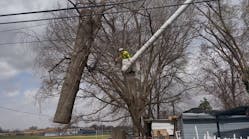In our industry, we’re exposed to Mother Nature’s elements year-round. While the hot summer months can be brutal, heat illnesses are very preventable with the right preparation.
Heat illnesses are caused by high temperatures and humidity. Working unprepared in high heat and humidity can be the perfect combination for any of the four most common heat illnesses: heat rash, heat cramps, heat exhaustion, and heat stroke.
To reduce your risk of heat illnesses, Cleveland Clinic suggests using the following steps to keep from getting overheated.
- Drink water every 15 minutes when working in a hot environment, even if you’re not thirsty. If you need to be out in extreme heat (heat index over 103°F), drink a total of two to four glasses (16 to 32 ounces) of water each hour.
- During strenuous, prolonged work over 2 hours in hot conditions, 1/3 to 1/2 of fluid intake should be in sports drinks to replace the electrolytes lost from sweating.
- Take periodic rest breaks in the shade, a cool area or air-conditioned space.
- When working or exercising outside in hot, humid weather, wear a wide-brimmed hat and loose, lightweight, light-colored cotton clothing.
- Do not drink beverages that contain caffeine.
- Wear sunscreen. A sunburn reduces your body’s ability to cool down. It can also dehydrate you.
- Pace yourself. Rest often.
Another tip for staying cool is to eat light — the more calories you take in, the more body heat you produce.
If you begin to overheat, develop a high temperature, notice bumps on your skin, muscle spasms, headache, dizziness, nausea, or several other symptoms, chances are, you may have one of these common illnesses.
Understanding how to prevent these illnesses can remove much of the risk of working outside during the summer months. When a heat-related illness occurs, it is critical to know how to recognize the symptoms quickly and administer the proper treatment. ACRT’s “Work Safe in the Heat” infographic reviews the warning signs and symptoms of heat illnesses, how to protect yourself and others, and steps to take if a person becomes ill.
Let’s review the four most common heat illnesses and how to treat them.
Heat Rash
Heat rash (also referred to as prickly heat or miliaria), is a stinging skin irritation that turns skin red. Symptoms can include red skin, itchy skin, pain that tingling or “prickly,” small bumps or blisters where your skin touches more of your skin, small bumps or blisters on areas that stay wet when you sweat, and infection.
First aid tips, recommended by Cleveland Clinic:
- Go somewhere cool – inside and air-conditioned, if possible.
- Gently dry off your skin.
- Put cold compresses on your skin.
- Don’t use any products that could block your pores. That includes baby powder, creams, and ointments.
- See your healthcare provider if the symptoms don’t improve.
Heat Cramps
Sweating profusely during strenuous activity depletes the body’s salt and moisture. This loss of electrolytes causes lower salt levels in muscles which leads to cramping – usually in the abdomen, arms, and legs.
First aid tips:
- Rest
- Cool down
- Stretch
- Replenish electrolytes with sports drinks or an alternative like Pedialyte®.
Heat Exhaustion
This illness is the body’s response to an excessive loss of the water and salt contained in sweat and results in reduced performance of one or more organ systems. Depending on the individual, this illness may take several days of exposure to develop. Activities from earlier in the week can lead to the unexpected onset of illness while in the field away from help. Symptoms can include headache, dizziness, or fainting, weakness and wet skin, irritability or confusion, thirst, nausea, or vomiting.
First aid tips:
- Remove tight or heavy clothing.
- Lay the individual down, slightly elevate their legs and feet, and have them drink cool water if they can tolerate it. Cold water can lead to abdominal pain and cramping.
- Cool the person by spraying or sponging with cool water and fanning.
- Monitor the person carefully. Contact a physician if symptoms do not improve within one hour. Call 911 immediately if the person's condition deteriorates.
Heat Stroke
Strenuous activity in excessive heat can lead to a rapid rise in core body temperature. When combined with failure of one of the body’s temperature-regulating mechanism — aka sweating — the body cannot cool down resulting in damage to the central nervous system, which can then cascade to affect other vital organs. Heat stroke is a medical emergency and can be permanently disabling or fatal if emergency treatment is not provided! Symptoms can include sudden and sustained loss of consciousness, seizures, and lack of sweat and flushed or dry skin. Often these symptoms are preceded by vision loss, rapid pulse and breathing, vertigo, nausea, headache, cerebral dysfunction, or other bizarre behavior such as agitation or confusion.
First aid tips, recommended by the Centers for Disease Control and Prevention:
- Call 911 right away. Heat stroke is a medical emergency.
- Stay with the individual.
- Move the person to a cooler place.
- Help lower the person’s temperature with cool cloths or a cool bath. Finding a cool bath in the field can be tricky, remember this is a medical emergency and asking a homeowner or business for assistance by allowing the individual inside shouldn’t be out of the question. Additionally, ice from your cooler placed on the major blood vessels in the neck, groin and armpits will lower core body temperatures.
- Do not give the person anything to drink.
Prevention is the best defense. Before you step out into the heat and humidity this summer, take time to reflect on some of the challenges you face while working in hot conditions and remember the signs and symptoms of heat illnesses.


